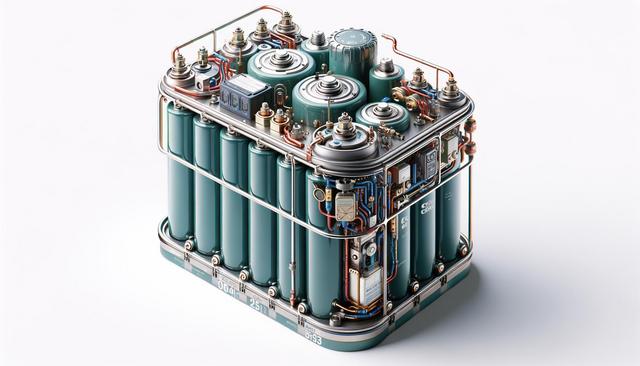Basic Structure of a Lead Acid Accumulator
A lead acid accumulator consists of several key components that work together to store and release electrical energy. The main parts include the electrodes (plates), the electrolyte, the separators, and the battery casing. The positive plate is made of lead dioxide (PbO₂), while the negative plate is composed of sponge lead (Pb). These plates are submerged in a sulfuric acid (H₂SO₄) electrolyte, which allows the chemical reactions to occur during charging and discharging cycles.
Each cell in the accumulator produces around 2 volts, and multiple cells are connected in series to achieve the desired voltage level. For example, a typical 12-volt battery consists of six 2-volt cells. The separators between the plates prevent short-circuiting while allowing the ionic flow necessary for electrochemical reactions. The battery casing, often made of durable plastic, protects the internal components and contains the electrolyte.
Main components include:
- Positive and negative plates
- Sulfuric acid electrolyte
- Separators
- Protective casing
This structure is designed to ensure both performance and safety during operation.
Working Principle and Chemical Reactions
The operation of a lead acid accumulator is based on reversible chemical reactions that occur during charging and discharging. When the battery discharges, the lead dioxide at the positive plate and the sponge lead at the negative plate react with the sulfuric acid to form lead sulfate (PbSO₄) and water. This reaction releases electrical energy that can be used to power various devices.
During charging, an external power source applies an electrical current that reverses the chemical reaction. The lead sulfate is converted back into lead dioxide and sponge lead, and the sulfuric acid concentration is restored. This cycle can be repeated many times, although the battery’s efficiency and capacity gradually decline over time.
The key reactions are:
- Discharging: Pb + PbO₂ + 2H₂SO₄ → 2PbSO₄ + 2H₂O
- Charging: 2PbSO₄ + 2H₂O → Pb + PbO₂ + 2H₂SO₄
This reversible process is what makes lead acid accumulators rechargeable and effective for long-term energy storage.
Types and Applications
Lead acid accumulators come in various types, each suited for different applications. The two main categories are flooded (wet cell) and sealed (valve-regulated) batteries. Flooded batteries require periodic maintenance, such as checking electrolyte levels and cleaning terminals. In contrast, sealed versions are designed for minimal maintenance and are often used in environments where convenience and safety are priorities.
These batteries are widely utilized in a range of sectors due to their dependable performance and relatively low cost. Common applications include:
- Automotive starting, lighting, and ignition (SLI) systems
- Backup power for uninterruptible power supplies (UPS)
- Off-grid renewable energy systems
- Industrial machinery and forklifts
- Telecommunications infrastructure
Each type is engineered to meet specific energy storage and delivery needs, allowing users to select the most appropriate solution for their context.
Advantages and Limitations
One of the main advantages of lead acid accumulators is their proven reliability over more than a century of use. Their robust design and ability to deliver high surge currents make them especially suitable for automotive and industrial applications. Additionally, the technology is well-understood, and a global infrastructure exists for manufacturing, recycling, and servicing these batteries.
However, lead acid batteries also have some limitations. They are relatively heavy and bulky compared to newer technologies, which can restrict their use in space-constrained applications. Their energy density is lower than that of lithium-ion or nickel-based batteries, meaning they store less energy per unit of weight. They also require proper maintenance to ensure long life, especially in the case of flooded types.
Pros include:
- Low initial cost
- High availability and recycling rate
- Reliable performance under varied conditions
Cons include:
- Lower energy density
- Heavier weight
- Regular maintenance (for flooded types)
Understanding these trade-offs is essential when evaluating whether a lead acid accumulator is suitable for a specific application.
Maintenance and Safety Considerations
Proper maintenance is crucial to extending the lifespan and ensuring the safe operation of lead acid accumulators. Regular inspections help detect issues like corrosion, fluid loss, and terminal buildup. For flooded batteries, maintaining the correct electrolyte level by topping up with distilled water is necessary. Overcharging should be avoided, as it can lead to overheating and gas release, which poses safety risks.
Safety measures should always be followed when handling or servicing lead acid batteries. This includes wearing protective gear, ensuring adequate ventilation, and following manufacturer guidelines. Spills of sulfuric acid must be cleaned immediately, and appropriate neutralizing agents should be on hand. Many modern systems incorporate safety features such as overcharge protection and spark-resistant terminals to minimize risks.
Key safety tips include:
- Always charge in a well-ventilated area
- Wear gloves and eye protection
- Inspect terminals and cables regularly
- Store in an upright position to prevent leaks
Adhering to these practices helps ensure the efficient and safe use of lead acid accumulators in both personal and commercial settings.
Summary and Practical Insights
Lead acid accumulators continue to play a vital role in energy storage across a wide range of industries. Their simple yet effective design, combined with a high recycling rate and global availability, makes them a practical choice for many users. While they may not offer the highest energy density or longest lifespan compared to newer alternatives, their reliability and affordability often outweigh these limitations in the right context.
For users considering lead acid batteries, understanding their structure and function is key to making informed decisions. Whether deployed in vehicles, backup power systems, or industrial equipment, proper maintenance and adherence to safety guidelines can significantly enhance their performance and longevity. As energy storage needs evolve, lead acid accumulators remain a dependable solution where proven technology and cost-effectiveness are priorities.




Leave a Reply